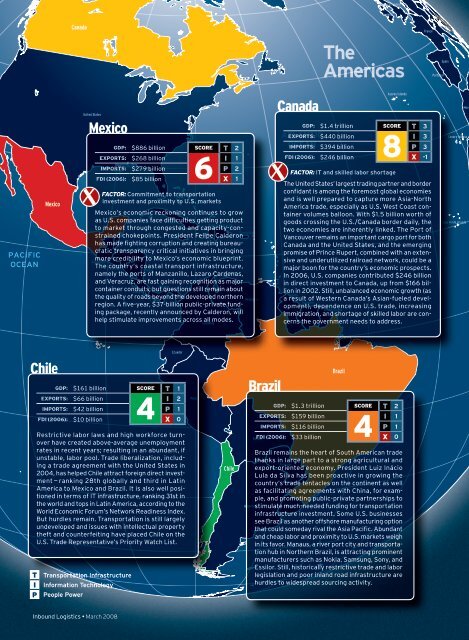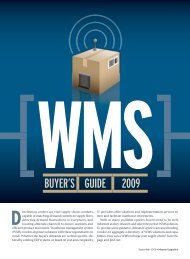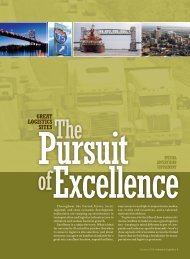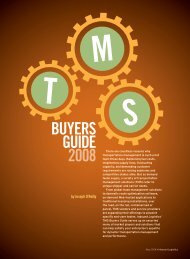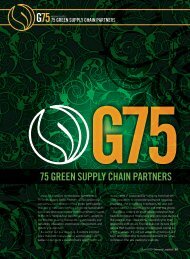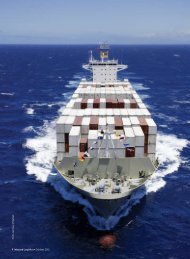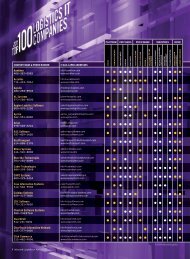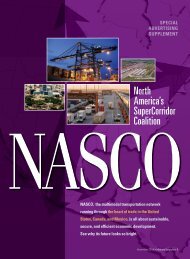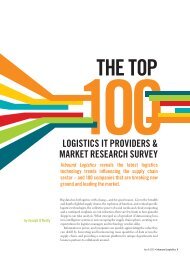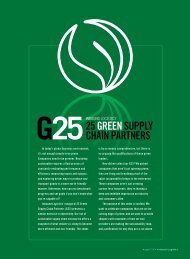Global Logistics Guide - Inbound Logistics
Global Logistics Guide - Inbound Logistics
Global Logistics Guide - Inbound Logistics
Create successful ePaper yourself
Turn your PDF publications into a flip-book with our unique Google optimized e-Paper software.
TheAmericasCanadaMexicoGDP: $1.4 trillion SCORE T 3GDP: $886 billion SCORE T 2EXPORTS: $268 billion6I 1IMPORTS: $279 billion P 2FDI (2006): $85 billion X 1FACTOR: Commitment to transportationinvestment and proximity to U.S. marketsMexico’s economic reckoning continues to growas U.S. companies face difficulties getting productto market through congested and capacity-con-strained chokepoints. President Felipe Calderonhas made fighting corruption and creating bureau-cratic transparency critical initiatives in bringingmore credibility to Mexico’s economic blueprint.The country’s coastal transport infrastructure,namely the ports of Manzanillo, Lazaro Cardenas,and Veracruz, are fast gaining recognition as majorcontainer conduits,but questions still remain aboutthe quality of roads beyond the developed northernregion. A five-year, $37-billion public-private fundingpackage, recently announced by Calderon, willhelp stimulate improvements across all modes.EXPORTS: $440 billion8I 3IMPORTS: $394 billion P 3FDI (2006): $246 billion X -1FACTOR: IT and skilled labor shortageThe United States’ largest trading partner and borderconfidant is among the foremost global economiesand is well prepared to capture more Asia-NorthAmerica trade, especially as U.S. West Coast containervolumes balloon. With $1.5 billion worth ofgoods crossing the U.S./Canada border daily, thetwo economies are inherently linked. The Port ofVancouver remains an important cargo port for bothCanada and the United States, and the emergingpromise of Prince Rupert, combined with an extensiveand underutilized railroad network, could be amajor boon for the country’s economic prospects.In 2006, U.S. companies contributed $246 billionin direct investment to Canada, up from $166 billionin 2002. Still, unbalanced economic growth (asa result of Western Canada’s Asian-fueled development),dependence on U.S. trade, increasingimmigration, and shortage of skilled labor are concernsthe government needs to address.ChileTIPGDP: $161 billion SCORE T 1EXPORTS: $66 billion4I 2IMPORTS: $42 billion P 1FDI (2006): $10 billion X 0Restrictive labor laws and high workforce turnoverhave created above-average unemploymentrates in recent years; resulting in an abundant, ifunstable, labor pool. Trade liberalization, includinga trade agreement with the United States in2004, has helped Chile attract foreign direct investment— ranking 28th globally and third in LatinAmerica to Mexico and Brazil. It is also well positionedin terms of IT infrastructure, ranking 31st inthe world and tops in Latin America, according to theWorld Economic Forum’s Network Readiness Index.But hurdles remain. Transportation is still largelyundeveloped and issues with intellectual propertytheft and counterfeiting have placed Chile on theU.S. Trade Representative’s Priority Watch List.Transportation InfrastructureInformation TechnologyPeople PowerBrazilGDP: $1.3 trillion SCORE T 2EXPORTS: $159 billion4I 1IMPORTS: $116 billion P 1FDI (2006): $33 billion X 0Brazil remains the heart of South American tradethanks in large part to a strong agricultural andexport-oriented economy. President Luiz InácioLula da Silva has been proactive in growing thecountry’s trade tentacles on the continent as wellas facilitating agreements with China, for example,and promoting public-private partnerships to stimulate much-needed funding for transportationinfrastructure investment. Some U.S. businessessee Brazil as another offshore manufacturing optionthat could someday rival the Asia Pacific. Abundantand cheap labor and proximity to U.S. markets weighin its favor. Manaus, a river port city and transportationhub in Northern Brazil, is attracting prominentmanufacturers such as Nokia, Samsung, Sony, andEssilor. Still, historically restrictive trade and laborlegislation and poor inland road infrastructure arehurdles to widespread sourcing activity.<strong>Inbound</strong> <strong>Logistics</strong> • March 2008


